Day 2 of a two day Private Tour today. It was raining when we met up in Wells, but thankfully the weather front cleared through on our way east along the coast and it was dry, and even sunny at times, through the rest of the day. A very gusty, blustery WSW wind had its pluses and minuses!
It had looked like it might be too wet and windy for Stiffkey Fen this morning, but as the rain appeared to be clearing, we decided to give it a go. A small group of House Martins were flying around over the copse by the path. A Goldcrest stopped to preen in the trees above our head as we walked down by the river. As we walked down along the footpath, we could hear Greenshanks and Wigeon calling from the Fen. As we got to the steps, a small group of Pink-footed Geese were flying west just beyond the seawall – a harbinger of things to come this morning.
From up on the seawall, there is a great view across Stiffkey Fen. It was immediately clear there were lots of birds, but no Spoonbills, which we had really hoped to see. The tide was already on its way out, so perhaps they had already made their way out onto the saltmarsh to feed. There were lots of other birds though. Stacks of duck having arrived here for the winter included lots of Wigeon and Teal, plus a fair few Pintail. In amongst them, we could see quite a few Ruff and down towards the front, lots of Black-tailed Godwits.
A few Greenshank flew off calling, four in total, towards the saltmarsh. It was only when we got a bit further along that we could see there were still 19 Greenshank roosting on the Fen, round behind the reeds. On the other side of the seawall, we heard calling and turned round to see two Kingfishers flying off from the fence around the sluice outfall. They shot past us and over the gate out towards the fields.
 Greenshank – one of at least 23 at Stiffkey Fen today
Greenshank – one of at least 23 at Stiffkey Fen today
We walked on round towards the harbour. One of the Greenshanks had dropped down into the channel and was feeding in the shallow water opposite the seawall. We got a nice look at it through the scope. Nearby, on the mud, there were lots of Redshank and a couple of Grey Plover too.
Scanning across the harbour, we could see lots of birds out on the emerging mudflats exposed by the receding tide – Oystercatchers, Black-tailed Godwits, Curlew, Grey Plover. There were a few Bar-tailed Godwits too, and we got one in the scope along with a few Black-tailed Godwits for comparison. In amongst the Black-tailed Godwits’ legs, were several Turnstones.
Much further over, out to sea, we could see three or four juvenile Gannets plunge-diving off the Point. There was also a steady stream of little groups of Pink-footed Geese arriving in off the sea, perhaps fresh in from Iceland for the winter. Even further out, we could just make out a Marsh Harrier battling in against the wind, still a long way out over the sea. Another migrant presumably just making its way on from the continent.
It was at this point, scanning between the mud around the harbour and the sea beyond, that we picked up a very distant bird coming in over the sandbar at the entrance to Blakeney Harbour, about 2km away. It was quite low over the sand and beating its wings hard. It was clearly a buzzard and immediately looked long-tailed and small-headed so, despite the distance, we had a pretty good idea what it was. Thankfully, having battled in to the headwind for a while, it tacked and came straight over the harbour towards us. Gradually we were able to confirm our suspicions – it was a juvenile Honey Buzzard, possibly fresh in from over the sea.
 Honey Buzzard – this juvenile battled in against the wind over Blakeney Harbour
Honey Buzzard – this juvenile battled in against the wind over Blakeney Harbour
As it came in over the mud on the nearside of the harbour, all the birds took flight and the Honey Buzzard several of the local gulls started mobbing it. It started to circle higher and we lost it for a minute in the melee. When we picked it up again it was just to the east of us and flying in over the saltmarsh on its own. When it got over the fields, it turned back west towards Stiffkey Fen, flying behind us, where it attracted the attention of the local crows and a male Marsh Harrier, which also started to mob it. At that point it changed direction again and drifted off east and away.
Through the scope, we could see the Honey Buzzard’s distinctive shape – as well as the long tail with several basal bars and small cuckoo-like head, we noted the pale patch under the primaries contrasting with the darker and strongly barred secondaries, the dark carpal batch and underwing coverts. The yellow cere confirmed it was a juvenile. Honey Buzzard is a distinctly uncommon bird here at this time of year, with just a few seen on migration, so this was a great bird to see. More than compensating us for the lack of Spoonbills perhaps!
Making our way back up onto the seawall, another flock of Pink-footed Geese was making its way west and started to whiffle down onto the Fen for a rest and bathe, presumably tired after a long journey over the sea. It was great to watch and listen to them as they dropped down and we got a good look at them through the scope, alongside the local Greylags for comparison.
 Pink-footed Geese – dropped into the Fen for a rest on their way
Pink-footed Geese – dropped into the Fen for a rest on their way
As we walked back along the seawall towards the footpath, we stopped for one last scan and noticed a large white bird in among all the geese on one of the islands. A Spoonbill, at the very last! Even better it was not asleep! It was an adult, preening itself with its long black bill with distinctive yellow tip. A perfect finish to a very successful couple of hours here.
 Spoonbill – had appeared on the Fen on our way back
Spoonbill – had appeared on the Fen on our way back
We had planned to visit Cley today, but with reports of a Lapland Bunting at Weybourne for the last few days, we decided to continue on to there first. We parked in the car park and walked west along the coastal footpath. It was exposed and very blustery here, but at least the sun was out now.
A couple of Meadow Pipits flew up from the grass beside the path and we could see a flock of Goldfinches further along in the bushes, but otherwise it was rather quiet here. We stopped a couple of times to scan the rough grass the other side of the fence and we had not gone too far when we heard the distinctive call of a Lapland Bunting – a dry rattle interspersed with a rather clipped but ringing ‘teu’. It flew in over the low ridge beyond the fence and circled over, but dropped back into the long grass on the ridge out of view. We stopped for a few minutes to see if it might reappear, but there was no further sign. It was perhaps too disturbed at this time of day, with walkers and dogs, for it to come out closer to the path. Still, it was nice to see it in flight and hear it.
Back to Salthouse and we stopped at the Iron Road. The muddy pool here is looking increasingly dry now and there were no birds on the remaining mud. A Little Egret was feeding in the low reeds at the back and a dark juvenile Marsh Harrier flew past. Another flock of Pink-footed Geese were flying in from the east and dropped down onto the marshes before they got to us.
On our way to Babcock Hide, as small bird flew across the grazing marshes and disappeared in the direction of the hide before we could get a good look at it – a Whinchat. Fortunately, looking back in the direction from which it had come, we found a second Whinchat perched on some dead thistles. We had a much better view of that one through the scope.
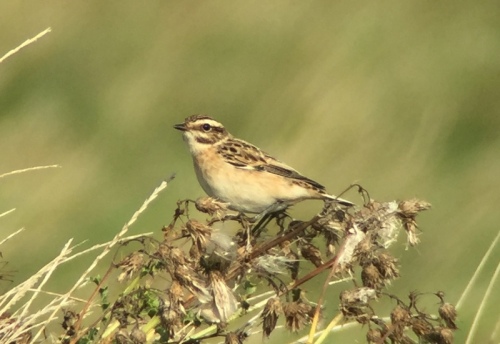 Whinchat – on the grazing meadow on the way to Babcock Hide
Whinchat – on the grazing meadow on the way to Babcock Hide
With little change in the water levels recently, the mud around the scrape from Babcock Hide was also looking rather dry. The ducks are enjoying it here though – mostly Teal, but also a handful of Wigeon, Gadwall and Shoveler. This is a good place to see birds moving along the coast though, and as we sat there a party of seven Swallows flew through on their way west and about 80 Lapwings flew over too.
After lunch round at the Cley visitor centre, we made our way out to the hides in the middle of the reserve. There were some nice waders right in front of Teal Hide – a mixture of Ruff and Black-tailed Godwits. Three Ruff picked their way across the mud just beyond the bank – a very educational mixture of two larger juvenile males and a single much smaller winter adult female.
 Ruff – smaller adult female in front, larger juvenile males behind
Ruff – smaller adult female in front, larger juvenile males behind
Doing a good job of hiding in the vegetation around the edge of the island, we found the two Little Stints which had been reported earlier. Tiny waders, they were picking around on the mud in amongst all the short rushes. A Dunlin just behind them provided a nice size comparison, highlighting just how small they are.
A female Marsh Harrier circled out over the scrape from the reedbed and flushed all the birds, and the smaller waders all landed again out in the open. It was only at this point that we realised there were actually four Little Stints on here, all smart juveniles. They stood with all the Dunlin out in the open for a few seconds, then made their way quickly back into the cover on the island.
A Greenshank had been sleeping over on the far side of the scrape, but had also been flushed by the Marsh Harrier and landed on the near edge just along from the hide. It was walking towards us and we had a good look at it, looking very smart in the afternoon sunshine. Before it got to the hide, it took off and flew straight across right in front of us and dropped over behind us.
 Greenshank – flew across right in front of Teal Hide
Greenshank – flew across right in front of Teal Hide
The mass arrival of Pink-footed Geese was a real theme of the day today and yet another flock dropped in to Simmond’s Scrape briefly, on their way west. Work is underway to reprofile the scrape at the moment and it was probably the approach of the returning excavator (after what appeared to be a rather extended lunch break) which quickly flushed them again. Their higher pitched, yelping calls contrasting with the deeper honking of the local Greylags.
 Pink-footed Geese – another flock dropped into Simmond’s Scrape briefly
Pink-footed Geese – another flock dropped into Simmond’s Scrape briefly
With all the activity, there was nothing much on Simmond’s Scrape today. A nice Comma butterfly was enjoying the sunshine in the shelter of the hides by the door to Dauke’s. There were also lots of dragonflies around the reserve, despite the wind – Common Darters and Migrant Hawkers.
 Comma – enjoying the afternoon sun
Comma – enjoying the afternoon sun
It was still very blustery round at the beach car park, but we made our way along the back of the beach towards North Scrape. A Whinchat perched up on the fence at the end of the Eye Field, but apart from a few Shelduck and smattering of other ducks, North Scrape itself looked disappointingly quiet. A few juvenile Gannets were circling offshore and plunge diving.
With a dark shower cloud approaching, we decided to make our way quickly back. As it was, there were no more than a couple of spots of rain. As we drove back along Beach Road, first a Stonechat and then a Wheatear flew up and landed on the fence posts.
 Wheatear – on the fence along Beach Road
Wheatear – on the fence along Beach Road
There was still time for one last quick stop, so we headed back for the shelter of Wells Woods. It was quiet initially walking through the trees – the blustery wind was penetrating even deep into the woods. As we made our way into the Dell, we came across a large tit flock. It was moving quickly, over our heads and back the way we had come. We tried to follow it, but lost it for a few minutes, eventually hearing the Long-tailed Tits calling and catching up with it just as it set off again.
Finally the birds found a slightly more sheltered spot in the trees, with even a bit of late afternoon sunshine catching the leaves, and stopped moving quite so quickly. At this point, we got a little time to watch them. As well as the Long-tailed Tits, there were Blue, Great and Coal Tits in the flock. With them were at least three Chiffchaffs and a Blackcap, a couple of Treecreepers and lost of Goldcrests. The Chiffchaffs were flitting around in the low brambles and wild roses, occasionally flycatching for insects. We had great views of a couple of Treecreepers climbing up the pines.
When the tit flock started to move off again it seemed to be heading up into the tops of the pines, so we went back and carried on through the Dell. When we got to the other side, we realised we were running out of time, so we turned to head back towards the car. We hadn’t gone far when we found ourselves surrounded by the tit flock again. Watching a tiny Goldcrest down in a wild rose at our feet was a great way to end two very exciting days of autumn birding.
 Goldcrest – feeding down at our feet
Goldcrest – feeding down at our feet

 Osprey – flew over from the direction of Thornham Harbour
Osprey – flew over from the direction of Thornham Harbour Peregrine – this juvenile landed on the freshmarsh
Peregrine – this juvenile landed on the freshmarsh Curlew Sandpiper – at least two were on the freshmarsh again today
Curlew Sandpiper – at least two were on the freshmarsh again today Curlew – there were several on the Volunteer Marsh
Curlew – there were several on the Volunteer Marsh Bar-tailed Godwit – on the Volunteer Marsh, by the path briefly
Bar-tailed Godwit – on the Volunteer Marsh, by the path briefly Black-tailed Godwit – feeding by the path on the tidal pools
Black-tailed Godwit – feeding by the path on the tidal pools Common Darter – lots were enjoying the autumn sunshine today
Common Darter – lots were enjoying the autumn sunshine today Hoopoe – feeding in the dunes by Brancaster golf course
Hoopoe – feeding in the dunes by Brancaster golf course Hoopoe – stunning with its crest raised
Hoopoe – stunning with its crest raised Pink-footed Geese – flying in to the pools to bathe
Pink-footed Geese – flying in to the pools to bathe Common Kestrel – devouring the last of a vole
Common Kestrel – devouring the last of a vole Long-tailed Tit – in the sallows on the way to the visitor centre
Long-tailed Tit – in the sallows on the way to the visitor centre Greater Scaup – on the reedbed pool
Greater Scaup – on the reedbed pool Golden Plover – with gold-spangled upperparts
Golden Plover – with gold-spangled upperparts Lapwing – numbers on the freshmarsh have increased
Lapwing – numbers on the freshmarsh have increased Bar-tailed Godwit – this one was feeding closer to the path
Bar-tailed Godwit – this one was feeding closer to the path Curlew Sandpiper – one of two juveniles still on the freshmarsh
Curlew Sandpiper – one of two juveniles still on the freshmarsh Black-tailed Godwit – mostly in winter plumage now
Black-tailed Godwit – mostly in winter plumage now Turnstone – or more accurately ‘Turnmud’ on this occasion!
Turnstone – or more accurately ‘Turnmud’ on this occasion! Common Redshank – looking for food on the Volunteer Marsh
Common Redshank – looking for food on the Volunteer Marsh House Martin – a flock of over 100 flew past us along the cliffs
House Martin – a flock of over 100 flew past us along the cliffs Wheatear – the first of several we saw today
Wheatear – the first of several we saw today Common Buzzard – drifted right overhead along Attenborough’s Walk
Common Buzzard – drifted right overhead along Attenborough’s Walk Ruff – two larger male Ruff and a smaller female Reeve
Ruff – two larger male Ruff and a smaller female Reeve Golden Plover – a large flock flew up from the scrapes as we walked out
Golden Plover – a large flock flew up from the scrapes as we walked out Caspian Gull – this 2nd winter dropped in briefly
Caspian Gull – this 2nd winter dropped in briefly Marsh Harrier – two were over the reedbed this afternoon
Marsh Harrier – two were over the reedbed this afternoon Common Snipe – feeding in the grass below the hide
Common Snipe – feeding in the grass below the hide
 Common Snipe – flushed out onto the bank by a Mute Swan
Common Snipe – flushed out onto the bank by a Mute Swan Whinchat – 1 of 3 on the Eye Field fence this afternoon
Whinchat – 1 of 3 on the Eye Field fence this afternoon Yellow-browed Warbler – elusive at first, in the birches
Yellow-browed Warbler – elusive at first, in the birches Yellow-browed Warbler – with pale yellow ‘brow’ and wing bars
Yellow-browed Warbler – with pale yellow ‘brow’ and wing bars Yellow-browed Warbler – two were in the birches together at one point
Yellow-browed Warbler – two were in the birches together at one point Common Buzzard – circled overhead as the day warmed up
Common Buzzard – circled overhead as the day warmed up Great Tit – pulling the hairs off a large, hairy caterpillar
Great Tit – pulling the hairs off a large, hairy caterpillar Red Kite – circled low over the trees
Red Kite – circled low over the trees Red Admiral – enjoying the autumn sunshine
Red Admiral – enjoying the autumn sunshine Wheatear – feeding on the harbour wall
Wheatear – feeding on the harbour wall Pink-footed Geese – we saw several small flocks flying in
Pink-footed Geese – we saw several small flocks flying in Spoonbills – 15 of the 30 on Stiffkey Fen today
Spoonbills – 15 of the 30 on Stiffkey Fen today Spoonbills – occasionally one would wake up and show off its bill
Spoonbills – occasionally one would wake up and show off its bill Kestrel – enjoying the late afternoon sunshine
Kestrel – enjoying the late afternoon sunshine Grey Plover – the first of many today
Grey Plover – the first of many today
 Oystercatchers – flying in off the Wash to roost on the pits
Oystercatchers – flying in off the Wash to roost on the pits



 Knot – about 60-70,000 birds in one huge swirling flock
Knot – about 60-70,000 birds in one huge swirling flock

 Knot – finally heading for the pits to roost
Knot – finally heading for the pits to roost
 Waders – jostling for position to roost on the pits
Waders – jostling for position to roost on the pits Curlew Sandpiper – a juvenile dwarfed by a Black-tailed Godwit behind
Curlew Sandpiper – a juvenile dwarfed by a Black-tailed Godwit behind Bar-tailed Godwit – with Black-tailed Godwit behind
Bar-tailed Godwit – with Black-tailed Godwit behind Little Stint – roosting in with the Dunlin
Little Stint – roosting in with the Dunlin Waders – still nervous, gathering back out on the Wash
Waders – still nervous, gathering back out on the Wash Curlew Sandpiper – showing well from the main path
Curlew Sandpiper – showing well from the main path Lapwing – numbers are now increasing
Lapwing – numbers are now increasing Bar-tailed Godwit – on the Volunteer Marsh on our way back
Bar-tailed Godwit – on the Volunteer Marsh on our way back Hobby – swept in past us after buzzing the freshmarsh
Hobby – swept in past us after buzzing the freshmarsh Bearded Tit – a smart male finally showed very well for us
Bearded Tit – a smart male finally showed very well for us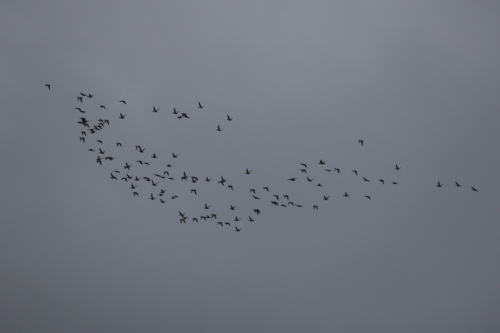 Wigeon – this flock was probably just arriving from Russia
Wigeon – this flock was probably just arriving from Russia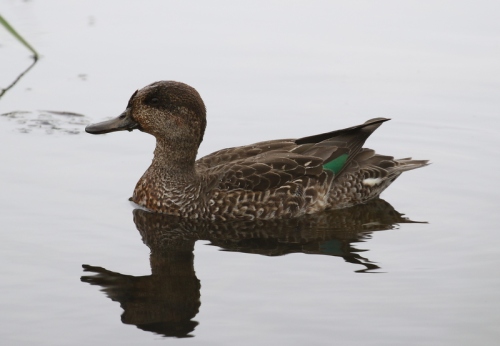 (Eurasian) Teal – in the ditch in front of Teal Hide this morning
(Eurasian) Teal – in the ditch in front of Teal Hide this morning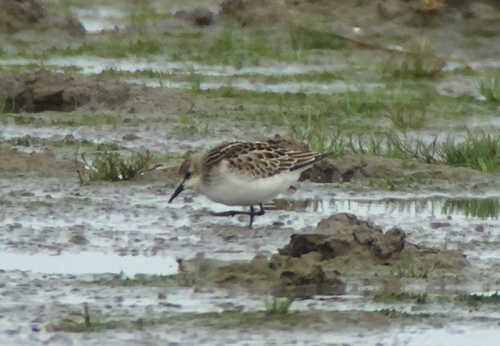 Little Stint – an impressive 9 were on Simmond’s Scrape
Little Stint – an impressive 9 were on Simmond’s Scrape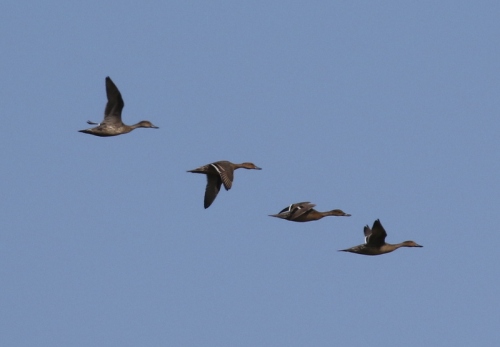 Pintail – these four were probably more fresh arrivals
Pintail – these four were probably more fresh arrivals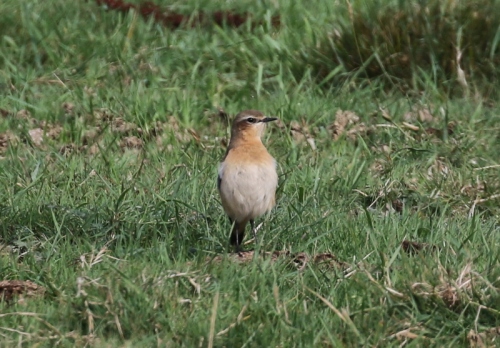 Wheatear – feeding on the grazing marshes on the way to Babcock Hide
Wheatear – feeding on the grazing marshes on the way to Babcock Hide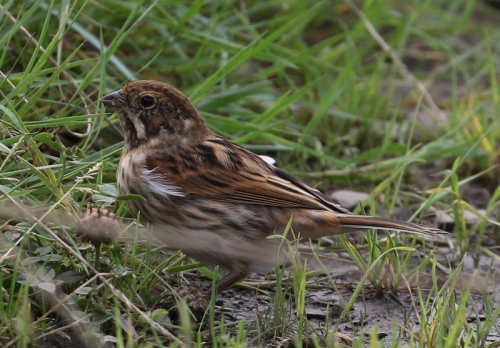 Reed Bunting – feeding along the path at Salthouse
Reed Bunting – feeding along the path at Salthouse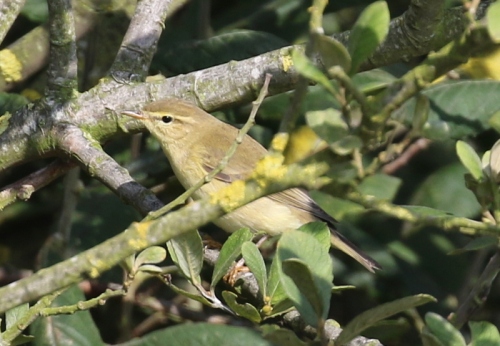 Willow Warbler – two of these appeared in the sallows
Willow Warbler – two of these appeared in the sallows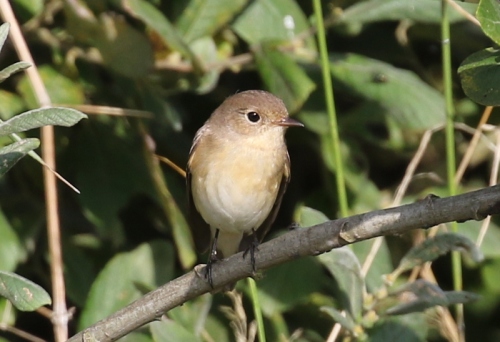 Red-breasted Flycatcher – perched out nicely for us
Red-breasted Flycatcher – perched out nicely for us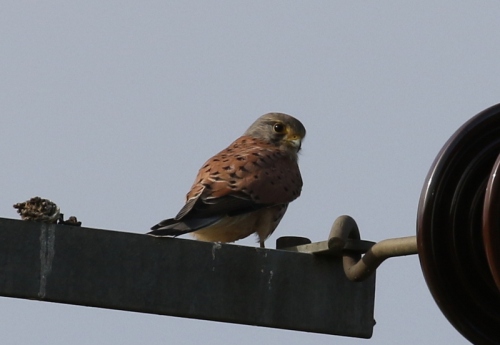 Kestrel – on the wires and pylons by the path at Stiffkey Fen
Kestrel – on the wires and pylons by the path at Stiffkey Fen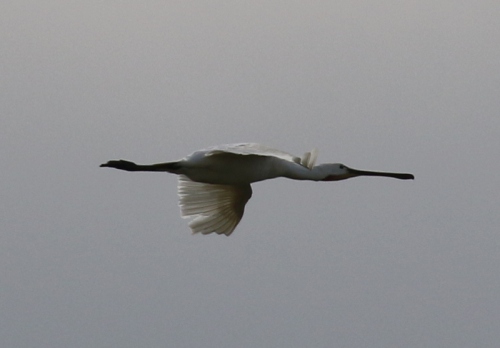 Spoonbill – flew off towards the saltmarsh
Spoonbill – flew off towards the saltmarsh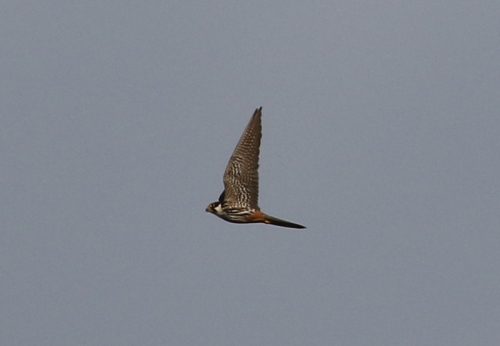 Hobby – chased a Dunlin from the Fen
Hobby – chased a Dunlin from the Fen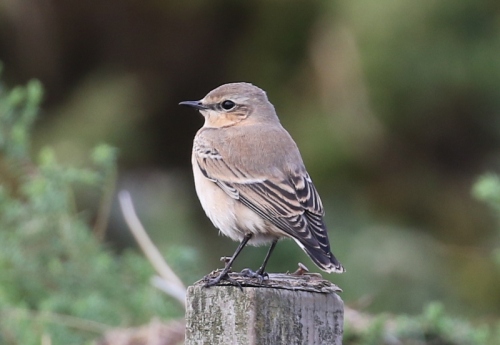 Wheatear – feeding on the path on the way out to the harbour
Wheatear – feeding on the path on the way out to the harbour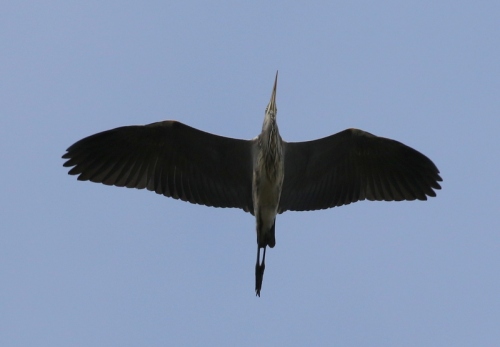 Grey Heron – possibly a freshly arrived migrant
Grey Heron – possibly a freshly arrived migrant Common Darter – enjoying the sunshine in the shelter of the path
Common Darter – enjoying the sunshine in the shelter of the path Peregrine – circled over the dunes
Peregrine – circled over the dunes Whinchat – found a sheltered perch out of the wind
Whinchat – found a sheltered perch out of the wind Brown Argus – a rather worn individual
Brown Argus – a rather worn individual Long-tailed Tits – we met several groups on the walk back
Long-tailed Tits – we met several groups on the walk back

 Pectoral Sandpiper – showed very well today
Pectoral Sandpiper – showed very well today Curlew Sandpipers – hiding in amongst the Wigeon
Curlew Sandpipers – hiding in amongst the Wigeon Spoonbills – twelve were at Stiffkey Fen this afternoon
Spoonbills – twelve were at Stiffkey Fen this afternoon Peregrine – our third of the day, out in the harbour
Peregrine – our third of the day, out in the harbour Small Heath – there were lots of butterflies out in the dunes
Small Heath – there were lots of butterflies out in the dunes Grayling – also plentiful in the dunes today
Grayling – also plentiful in the dunes today Red-backed Shrike – we had great views of this juvenile in the dunes
Red-backed Shrike – we had great views of this juvenile in the dunes Willow Warbler – calling in the trees
Willow Warbler – calling in the trees Redstart – flew along the edge of the path ahead of us
Redstart – flew along the edge of the path ahead of us Spotted Flycatcher – another migrant in the dunes
Spotted Flycatcher – another migrant in the dunes Glossy Ibis – looking very glossy indeed in the afternoon sunlight
Glossy Ibis – looking very glossy indeed in the afternoon sunlight Garganey – showed really well once flushed out by a passing Grey Heron
Garganey – showed really well once flushed out by a passing Grey Heron Willow Emerald – we saw several of these damselflies at Strumpshaw today
Willow Emerald – we saw several of these damselflies at Strumpshaw today Wood Sandpiper – at the front of North Scrape
Wood Sandpiper – at the front of North Scrape Reed Warbler – here’s one outside the hide from the other day
Reed Warbler – here’s one outside the hide from the other day Common Buzzard – on the move, five circled high over the hides
Common Buzzard – on the move, five circled high over the hides Wheatear – a rather rich orange-breasted male
Wheatear – a rather rich orange-breasted male Stonechat – perched up nicely in the brambles nearby
Stonechat – perched up nicely in the brambles nearby Whinchat – rather less obliging than the Stonechats
Whinchat – rather less obliging than the Stonechats